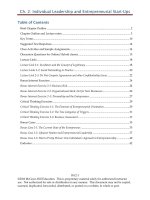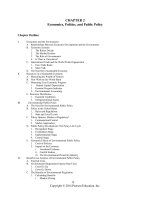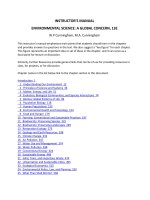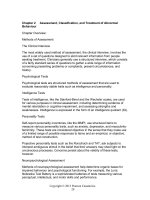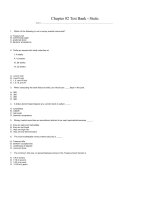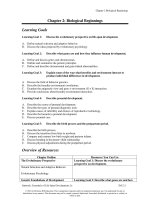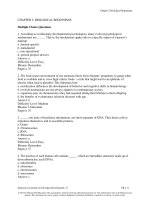Test bank and solution manual of CH02 science matter and energy (1)
Bạn đang xem bản rút gọn của tài liệu. Xem và tải ngay bản đầy đủ của tài liệu tại đây (426.97 KB, 18 trang )
CHAPTER 2—SCIENCE, MATTER, AND ENERGY
MULTIPLE CHOICE
1. Which statement best describes the Bormann-Likens controlled experiment in forest valleys in New
Hampshire that compared water flowing out of deforested areas to undisturbed areas?
a. The deforested area was greater in volume by 30 to 40%
b. The deforested area was less in volume by 30 to 40%
c. The deforested area had more soil nutrients dissolved in the water
d. The deforested area was less in volume by 30 to 40% and had fewer soil nutrients
dissolved in the water
e. The deforested area was greater in volume by 30 to 40% and had more soil nutrients
dissolved in the water
ANS: E
PTS: 1
DIF: Moderate
TOP: CORE CASE STUDY
2. The Bormann-Likens study in the Hubbard Brooks Experimental Forest in New Hampshire can best be
described as
a. a comparison of a control site with an experimental site in nature
b. what can occur in a forest watershed without plants to absorb water
c. an example of how scientists learn about the effects of our actions on natural systems
d. a comparison of a control site with an experimental site in nature and a study of what can
occur in a forest watershed without plants to absorb and retain water
e. a comparison of a control and an experimental site, a study of what can occur in a forest
watershed without plants to absorb water, and an example of how scientists learn about the
effects of our actions on natural systems.
ANS: E
PTS: 1
DIF: Moderate
TOP: CORE CASE STUDY
3. Science
a. is a study of the history of the natural world
b. attempts to discover order in nature to interpret the past
c. is best described as a random collection of facts
d. is supported by small amounts of evidence
e. is an endeavor to discover how nature works
ANS: E
PTS: 1
DIF: Moderate
TOP: 2-1 WHAT DO SCIENTISTS DO?
4. When scientists are testing ideas to determine facts, they
a. follow a specific set of logical steps
b. report observations to the scientific community without data collection
c. use different steps that are unique to each scientist
d. use only mathematical modeling
e. first ask fellow scientists at annual meetings what steps to take
ANS: A
PTS: 1
DIF: Moderate
TOP: 2-1 WHAT DO SCIENTISTS DO?
18
5. Scientific hypotheses differ from scientific theories in that they are
a. widely accepted descriptions of what we find happening over and over in nature
b. tentative explanations that need further evaluation
c. not subject to proper investigation and testing
d. arrived at after extensive mathematical modeling
e. tentative explanations that need further evaluation and not subject to proper investigation
and testing
ANS: B
PTS: 1
DIF: Moderate
TOP: 2-1 WHAT DO SCIENTISTS DO?
6. A classmate tells you that a statement heard on the news about an environmental process noted in a
local ecosystem cannot be true because it has not been scientifically proven. You realize that
a. this classmate is misinformed because science cannot prove anything, but it can disprove
events conclusively.
b. this classmate is misinformed because science can neither prove or disprove anything
absolutely.
c. this classmate is misinformed because the process in question actually has been proven
scientifically.
d. this classmate is correct.
e. this classmate has confused scientific theories and scientific laws
ANS: B
PTS: 1
DIF: Moderate
TOP: 2-1 WHAT DO SCIENTISTS DO?
7. Which of the following choices best describes the sequence scientists typically use in the beginning
stages of their investigations about how nature works?
a. analyze data -> search literature -> perform experiment -> identify a problem -> ask a
question
b. ask a question -> search literature -> perform experiment -> analyze data -> identify a
problem
c. search literature -> ask a question -> identify a problem -> analyze data -> perform
experiment
d. identify a problem ->search literature -> ask a question -> perform experiment -> analyze
data
e. ask a question->search literature -> identify a problem -> perform experiment -> analyze
data
ANS: D
PTS: 1
DIF: Difficult
TOP: 2-1 WHAT DO SCIENTISTS DO?
8. Which of the following does not characterize frontier science?
a. It often captures news headlines because it is controversial.
b. It may deal with preliminary data.
c. It may eventually be validated.
d. Scientists always agree on the meaning and accuracy of the data involved.
e. It may eventually be discredited.
ANS: D
PTS: 1
DIF: Moderate
TOP: 2-1 WHAT DO SCIENTISTS DO?
19
A tiny, tawny colored butterfly called the Carson Wandering Skipper was always known for its small
and very localized populations. Typically, it was found along the western Nevada and eastern
California high desert areas. It was always located close to hot springs and other wet areas that
supported salt grass, the host plant it depended on.
Recently, the populations went into a steep decline, and a last hold-out area was threatened by
imminent construction of a freeway bypass. Biologists became alarmed and began an intensive search
for populations in locations other than the spot designated for the freeway bypass. They began their
search by identifying all known locations of hot springs, in hopes of finding small populations of the
Carson Wandering Skipper close by.
9. The biologists’ observations that the Carson Wandering Skipper populations had declined is an
example of
a. data analysis
b. identifying a problem
c. performing an experiment
d. proposing a hypothesis
e. making testable predictions
ANS: B
PTS: 1
DIF: Difficult
TOP: 2-1 WHAT DO SCIENTISTS DO?
10. As they searched for previously unknown populations of the Carson Wandering Skipper, biologists
wondered if hot springs were absolutely essential to its survival. This phase of the investigation is
a. finding out what is known and asking a question
b. analyzing data and asking a question
c. Asking a question and testing predictions
d. accepting their hypothesis and analyzing data
e. accepting their hypothesis and asking a question
ANS: A
PTS: 1
DIF: Difficult
TOP: 2-1 WHAT DO SCIENTISTS DO?
11. The scientists, with enough data,
a. would be able to prove that there is a correlation between butterfly populations and hot
springs
b. would not be able to prove a correlation between the butterfly populations and hot springs,
but could disprove it
c. Would be able to prove or disprove a correlation, depending on the numbers
d. would not be able to prove or disprove a correlation between the butterfly populations and
hot springs
e. would be able to prove that there is a correlation between the butterfly populations and hot
springs, but would not be able to disprove it
ANS: D
PTS: 1
DIF: Moderate
TOP: 2-1 WHAT DO SCIENTISTS DO?
20
12. What are the important steps involved in critical thinking?
a. Be skeptical about everything you read or hear and be open to many viewpoints
b. Look at the evidence and evaluate it as well as related information and a variety of
opinions.
c. Identify and evaluate your personal beliefs and biases.
d. Identify and evaluate your personal beliefs and biases and be skeptical about everything
you read or hear.
e. Look at the evidence and evaluate it as well as related information, identify and evaluate
your personal beliefs and biases, be skeptical about everything you read or hear and be
open to many viewpoints.
ANS: E
PTS: 1
DIF: Easy
TOP: 2-1 WHAT DO SCIENTISTS DO?
13. Scientific theories are
a. frequently overturned and changed because they are, in fact, just theories.
b. overturned on a regular basis at periodic scheduled meetings of the scientific community
to evaluate the validity of all scientific theories.
c. never overturned.
d. rarely overturned unless new evidence discredits them.
e. overturned only as a result of Supreme Court decisions.
ANS: D
PTS: 1
DIF: Moderate
TOP: 2-1 WHAT DO SCIENTISTS DO?
14. Matter is best described as
a. anything that has mass and occupies space
b. something that has the capacity to do work
c. something that can exist as a solid, liquid, or gas
d. something that can produce change
e. is anything that has mass and occupies space and can exist as a solid, liquid, or gas
ANS: E
PTS: 1
DIF: Moderate
TOP: 2-2 WHAT IS MATTER AND WHAT HAPPENS WHEN IT UNDERGOES CHANGE?
15. All of the following are elements except
a. water
b. oxygen
c. nitrogen
d. hydrogen
e. carbon
ANS: A
PTS: 1
DIF: Easy
TOP: 2-2 WHAT IS MATTER AND WHAT HAPPENS WHEN IT UNDERGOES CHANGE?
16. The atomic number is the number of
a. atoms in a molecule
b. protons in an atom
c. nuclei in a molecule
d. electrons in an atom
e. protons and neutrons in an atom
ANS: B
PTS: 1
DIF: Easy
TOP: 2-2 WHAT IS MATTER AND WHAT HAPPENS WHEN IT UNDERGOES CHANGE?
21
17. Protons, neutrons, and electrons are all
a. forms of energy
b. equal in mass
c. subatomic particles
d. negative ions
e. charged particles
ANS: C
PTS: 1
DIF: Easy
TOP: 2-2 WHAT IS MATTER AND WHAT HAPPENS WHEN IT UNDERGOES CHANGE?
18. The atomic mass number is equal to the sum of the
a. neutrons and isotopes
b. neutrons and electrons
c. neutrons and protons
d. protons, neutrons, and electrons
e. protons only
ANS: C
PTS: 1
DIF: Easy
TOP: 2-2 WHAT IS MATTER AND WHAT HAPPENS WHEN IT UNDERGOES CHANGE?
19. An element
a. is identical to a compound
b. is made up of compounds
c. can combine with one or more other element to make a compound
d. exists only in a pure form as a single element, and never combines with other elements
e. more than one of these answers
ANS: C
PTS: 1
DIF: Easy
TOP: 2-2 WHAT IS MATTER AND WHAT HAPPENS WHEN IT UNDERGOES CHANGE?
20. The commonest form of the Carbon atom that exists is at times referred to as C12. An isotope of this
atom is called C14. C14 must have a different number of___________than C12.
a. ions
b. protons
c. atoms
d. neutrons
e. electrons
ANS: D
PTS: 1
DIF: Moderate
TOP: 2-2 WHAT IS MATTER AND WHAT HAPPENS WHEN IT UNDERGOES CHANGE?
21. Ions are atoms or groups of atoms that have
a. Gained or lost an electron
b. Gained or lost a proton
c. Gained or lost a neutron
d. Gained or lost either an electron or a proton
e. different numbers of protons and neutrons in the same atom
ANS: A
PTS: 1
DIF: Moderate
TOP: 2-2 WHAT IS MATTER AND WHAT HAPPENS WHEN IT UNDERGOES CHANGE?
22
22. Which list of items contains only ions?
a. CO2, H2O, Na+, Hb. Na+, H-, Pb, Hg
c. Pb, Hg, CO2,NaCl
d. Cl-, Na+, Ca2+, NO3e. NaCl, NO, CO, NaOH
ANS: D
PTS: 1
DIF: Moderate
TOP: 2-2 WHAT IS MATTER AND WHAT HAPPENS WHEN IT UNDERGOES CHANGE?
23. An acidic solution would have
a. more hydroxide ions than hydrogen ions
b. more hydrogen ions than hydroxide ions
c. a pH less than 7
d. a pH greater than 7
e. more hydrogen ions than hydroxide ions and a pH less than 7
ANS: E
PTS: 1
DIF: Moderate
TOP: 2-2 WHAT IS MATTER AND WHAT HAPPENS WHEN IT UNDERGOES CHANGE?
24. All organic compounds are characterized by the presence of
a. carbon
b. hydrogen
c. oxygen
d. nitrogen
e. phosphorus
ANS: A
PTS: 1
DIF: Easy
TOP: 2-2 WHAT IS MATTER AND WHAT HAPPENS WHEN IT UNDERGOES CHANGE?
25. Which of the following sources of iron would be of the highest quality?
a. iron deposits on the ocean floor
b. a field of spinach
c. a large scrap metal junkyard
d. a half-mile deep deposit of iron ore
e. soil that is high in iron content
ANS: C
PTS: 1
DIF: Difficult
TOP: 2-2 WHAT IS MATTER AND WHAT HAPPENS WHEN IT UNDERGOES CHANGE?
26. Which of the following contains all of the others?
a. chromosomes
b. genes
c. cells
d. DNA molecules
e. cell nuclei
ANS: C
PTS: 1
DIF: Moderate
TOP: 2-2 WHAT IS MATTER AND WHAT HAPPENS WHEN IT UNDERGOES CHANGE?
23
27. The smallest functional and structural unit of life is the
a. ion
b. atom
c. compound
d. molecule
e. cell
ANS: E
PTS: 1
DIF: Easy
TOP: 2-2 WHAT IS MATTER AND WHAT HAPPENS WHEN IT UNDERGOES CHANGE?
28. Which organic polymer consists of two or more monomers of simple sugars such as glucose?
a. lipids
b. proteins
c. nucleic acids
d. complex carbohydrates
e. nucleic acids and complex carbohydrates
ANS: D
PTS: 1
DIF: Moderate
TOP: 2-2 WHAT IS MATTER AND WHAT HAPPENS WHEN IT UNDERGOES CHANGE?
29. Genetic information is contained in coded units on chromosomes called
a. DNA molecules
b. Genes
c. macromolecules
d. nucleotides
e. proteins
ANS: B
PTS: 1
DIF: Moderate
TOP: 2-2 WHAT IS MATTER AND WHAT HAPPENS WHEN IT UNDERGOES CHANGE?
30. The law of conservation of matter states that
a. Atoms can be created.
b. Atoms can be destroyed.
c. Atoms cannot be created or destroyed.
d. Atoms can be destroyed if we compost them.
e. Atoms can be created through nuclear fission.
ANS: C
PTS: 1
DIF: Easy
TOP: 2-2 WHAT IS MATTER AND WHAT HAPPENS WHEN IT UNDERGOES CHANGE?
31. If a carbon atom combines with oxygen atoms to form CO2, this would be described as a
a. Physical change.
b. Chemical change.
c. It is both a physical and chemical change.
d. First, it is a physical change, but then it becomes a chemical change.
e. It is not a physical change or a chemical change. It is scientific change.
ANS: B
PTS: 1
DIF: Easy
TOP: 2-2 WHAT IS MATTER AND WHAT HAPPENS WHEN IT UNDERGOES CHANGE?
24
32. Energy can be formally defined as
a. the velocity of any moving object
b. the heat generated by atoms losing electrons
c. the ability to do work or produce heat transfer
d. the displacement of heat from the Sun to the Earth
e. the process of moving objects
ANS: C
PTS: 1
DIF: Moderate
TOP: 2-3 WHAT IS ENERGY AND WHAT HAPPENS WHEN IT UNDERGOES CHANGE?
33. Most forms of energy can be classified as either
a. chemical or physical
b. kinetic or mechanical
c. potential or mechanical
d. chemical or kinetic
e. potential or kinetic
ANS: E
PTS: 1
DIF: Moderate
TOP: 2-3 WHAT IS ENERGY AND WHAT HAPPENS WHEN IT UNDERGOES CHANGE?
34. All of the following are examples of kinetic energy except
a. a speeding bullet
b. a car battery
c. a flow of electric current
d. a falling rock
e. flowing water
ANS: B
PTS: 1
DIF: Moderate
TOP: 2-3 WHAT IS ENERGY AND WHAT HAPPENS WHEN IT UNDERGOES CHANGE?
35. An example of potential energy is
a. electricity flowing through a wire
b. the chemical energy in a candy bar
c. a bullet fired at high velocity
d. a leaf falling from a tree
e. water flowing
ANS: B
PTS: 1
DIF: Moderate
TOP: 2-3 WHAT IS ENERGY AND WHAT HAPPENS WHEN IT UNDERGOES CHANGE?
36. Which of the following is the best description of the first law of thermodynamics?
a. Atoms cannot be created or destroyed.
b. Energy input always equals energy output.
c. Heat is a form of kinetic energy.
d. Solar energy is converted into chemical energy in living systems.
e. All of these answers apply to the first law of thermodynamics.
ANS: B
PTS: 1
DIF: Difficult
TOP: 2-3 WHAT IS ENERGY AND WHAT HAPPENS WHEN IT UNDERGOES CHANGE?
25
37. Wind farms are viable options for supplying more of our energy needs in the future because:
a. high speed wind is a form of medium-quality energy
b. high speed wind is a form of high-quality energy
c. high speed wind is a form of low-quality energy
d. all speeds of wind are high quality energy
e. wind is not an energy form at all
ANS: B
PTS: 1
DIF: Moderate
TOP: 2-3 WHAT IS ENERGY AND WHAT HAPPENS WHEN IT UNDERGOES CHANGE?
38. The direct input of solar energy produces which of the following forms of renewable (indirect) solar
energy?
a. wind
b. falling and flowing water
c. biomass
d. wind, falling and flowing water, and biomass
e. only wind and falling and flowing water
ANS: D
PTS: 1
DIF: Moderate
TOP: 2-3 WHAT IS ENERGY AND WHAT HAPPENS WHEN IT UNDERGOES CHANGE?
39. The amount of useful work accomplished by a particular input of energy into a system is
a. Energy quality
b. Energy potential
c. Energy capacity
d. Energy efficiency
e. Energy loss
ANS: D
PTS: 1
DIF: Moderate
TOP: 2-3 WHAT IS ENERGY AND WHAT HAPPENS WHEN IT UNDERGOES CHANGE?
40. Which of the following energy forms is high quality?
a. coal
b. the heat dispersed in the ocean
c. electricity
d. food
e. coal, electricity and food
ANS: E
PTS: 1
DIF: Difficult
TOP: 2-3 WHAT IS ENERGY AND WHAT HAPPENS WHEN IT UNDERGOES CHANGE?
41. What percentage of useful energy in the United States is either unavoidably or unnecessarily wasted?
a. 43%
b. 84%
c. 35%
d. 41%
e. Energy in the United States is not wasted.
ANS: B
PTS: 1
DIF: Easy
TOP: 2-3 WHAT IS ENERGY AND WHAT HAPPENS WHEN IT UNDERGOES CHANGE?
26
42. Scientists Bormann and Likens demonstrated in their experiment on a clear-cut forest that
a. A cleared forest is more sustainable than an uncleared forest.
b. An uncleared forest is more sustainable than a cleared forest.
c. Cleared and uncleared forests have the same sustainability.
d. Clearing a forest violates the second law of thermodynamics.
e. At least two of these answers are correct.
ANS: B
PTS: 1
DIF: Moderate
TOP: 2-3 WHAT IS ENERGY AND WHAT HAPPENS WHEN IT UNDERGOES CHANGE?
43. A form of kinetic energy that travels in the form of waves as a result of changes in electrical and
magnetic fields is
a. wind
b. electromagnetic radiation
c. waterfalls
d. electricity
e. solar radiation
ANS: B
PTS: 1
DIF: Moderate
TOP: 2-3 WHAT IS ENERGY AND WHAT HAPPENS WHEN IT UNDERGOES CHANGE?
44. Which of the following is the best short summary of the law of conservation of matter?
a. There is no away.
b. You cannot get something for nothing.
c. You cannot break even.
d. You can break even, but not get something for nothing.
e. You can get something for nothing, but cannot break even.
ANS: A
PTS: 1
DIF: Easy
TOP: 2-3 WHAT IS ENERGY AND WHAT HAPPENS WHEN IT UNDERGOES CHANGE?
45. Some forms of electromagnetic radiation with short wavelengths are:
a. Visible light and IR radiation
b. Visible light and x-rays
c. x-rays and IR
d. gamma rays and UV radiation
e. Visible light and gamma rays
ANS: D
PTS: 1
DIF: Moderate
TOP: 2-3 WHAT IS ENERGY AND WHAT HAPPENS WHEN IT UNDERGOES CHANGE?
46. Which of the following are widely used technologies that are responsible for wasting enormous
amounts of energy?
a. the compact fluorescent light bulb and the internal combustion engine
b. solar cells and incandescent light bulbs
c. the incandescent light bulb and the internal combustion engine
d. PV cells and the internal combustion engine
e. LED bulbs and the internal combustion engine
ANS: C
PTS: 1
DIF: Moderate
TOP: 2-3 WHAT IS ENERGY AND WHAT HAPPENS WHEN IT UNDERGOES CHANGE?
27
TRUE/FALSE
1. Since scientific theories are tentative explanations, they should not be taken seriously.
ANS: F
PTS: 1
DIF: Moderate
2. Scientists analyze data before they take any other steps to investigate natural processes, since that is
the only logical place to start.
ANS: F
PTS: 1
DIF: Moderate
3. The two chemical forms of matter are elements and compounds.
ANS: T
PTS: 1
DIF: Easy
4. Chemical elements cannot be broken down into simpler substances.
ANS: T
PTS: 1
DIF: Easy
5. The steps in the scientific investigative process are always followed in the same sequence by every
scientist, without fail.
ANS: F
PTS: 1
DIF: Easy
6. When matter undergoes physical changes, the chemical composition also changes.
ANS: F
PTS: 1
DIF: Easy
7. Hydrocarbons are organic compounds.
ANS: T
PTS: 1
DIF: Easy
8. The very first step in the scientific process is to find out what is known about the problem.
ANS: F
PTS: 1
DIF: Moderate
9. When electrical energy lights an incandescent light bulb, 50 percent of the energy produces light.
ANS: F
PTS: 1
DIF: Easy
10. When energy changes from one form to another, it always goes from a more useful to a less useful
form.
ANS: T
PTS: 1
DIF: Easy
11. The idea that all elements are made up of molecules is called the atomic theory.
ANS: F
PTS: 1
DIF: Easy
12. A chemical element cannot be broken down into simpler substances by chemical means.
ANS: T
PTS: 1
DIF: Easy
28
13. Atoms as a whole have no net electrical charge.
ANS: T
PTS: 1
DIF: Easy
14. The atomic number of an atom designates the number of protons and neutrons found in its nucleus.
ANS: F
PTS: 1
DIF: Easy
15. In the scientific process, projections are tested with further experiments, models or observations.
ANS: T
PTS: 1
DIF: Easy
COMPLETION
1. In a scientific investigation, one of the groups involved in the investigation has a chosen variable
changed in a known way. This group is designated as the ____________________group.
ANS: experimental
PTS: 1
DIF: Moderate
2. If an overwhelming body of observations and measurements supports a scientific hypothesis, it
becomes known as a(n) ____________________.
ANS: scientific theory
PTS: 1
DIF: Moderate
3. A tentative explanation that needs further investigation is called a(n) ____________________.
ANS: hypothesis
PTS: 1
DIF: Easy
4. Matter that is near the Earth's surface, that is highly concentrated, and that has great potential for use
as a resource is referred to as ____________________.
ANS: high quality
PTS: 1
DIF: Easy
5. ____________________ consists of elements and compounds.
ANS: Matter
PTS: 1
DIF: Easy
29
6. A chemical that is a combination of two or more different elements is called a(n)
____________________.
ANS: compound
PTS: 1
DIF: Easy
7. An atom or group of atoms with one or more net positive or negative charges is called a(n)
____________________.
ANS: ion
PTS: 1
DIF: Easy
8. The pH of a solution is a measure of the ____________________ ions and ____________________
ions.
ANS:
hydrogen, hydroxide
hydroxide, hydrogen
PTS: 1
DIF: Moderate
9. ________________ ____________occurs when two isotopes of light elements are forced together at
extremely high temperatures until they fuse to form a heavier nucleus.
ANS: nuclear fusion
PTS: 1
DIF: Moderate
10. ___________________ ______________occurs when the nuclei of certain isotopes with large mass
numbers are split apart into lighter nuclei when struck by a neutron.
ANS: nculear fission
PTS: 1
DIF: Moderate
11. An ion that is an essential nutrient for plant growth, and which was studied by Bormann and Likens, is
the ____________________ ion.
ANS: nitrate
PTS: 1
DIF: Moderate
12. A simple carbohydrate that plants and animals use to obtain energy is ____________________.
ANS: glucose
PTS: 1
DIF: Easy
30
13. Organic compounds always contain ____________________ atoms.
ANS: carbon
PTS: 1
DIF: Easy
14. Genes are segments of ____________________.
ANS: DNA
PTS: 1
DIF: Moderate
15. Macromolecules formed from a number of monomers are called ____________________.
ANS: polymers
PTS: 1
DIF: Moderate
MATCHING
Match items with their appropriate chemical description.
a. S
g. Na
b. H+
h. nucleus
c. electron
i. mass number
d. proton
j. NO3e. neutron
k. isotopes
f. CO2
1.
2.
3.
4.
5.
6.
7.
8.
9.
10.
11.
The chemical symbol for sodium
A subatomic particle with no net electrical charge
The nitrate ion
The small, dense center of an atom
The total number of protons and neutrons in an atom’s nucleus
Subatomic particle with a positive charge
The chemical symbol for sulfur
A compound
Atoms with variable numbers of neutrons
Subatomic particle with a negative charge
Chemical symbol for the hydrogen ion
1.
2.
3.
4.
5.
6.
7.
8.
9.
10.
ANS:
ANS:
ANS:
ANS:
ANS:
ANS:
ANS:
ANS:
ANS:
ANS:
G
E
J
H
I
D
A
F
K
C
PTS:
PTS:
PTS:
PTS:
PTS:
PTS:
PTS:
PTS:
PTS:
PTS:
1
1
1
1
1
1
1
1
1
1
DIF:
DIF:
DIF:
DIF:
DIF:
DIF:
DIF:
DIF:
DIF:
DIF:
Moderate
Moderate
Moderate
Moderate
Moderate
Moderate
Moderate
Moderate
Moderate
Moderate
31
11. ANS: B
PTS: 1
DIF: Moderate
Match the items below with the correct energy or matter quality below.
a. High-quality matter
b. Low-quality matter
c. High-quality energy
d. Low-quality energy
e. Both high-quality matter and high-quality energy
12.
13.
14.
15.
16.
17.
18.
19.
20.
21.
salt
coal
gasoline
aluminum ore
salt water
heat in oceans
oil in barrels
automobile emissions
nuclear fission
concentrated sunlight
12.
13.
14.
15.
16.
17.
18.
19.
20.
21.
ANS:
ANS:
ANS:
ANS:
ANS:
ANS:
ANS:
ANS:
ANS:
ANS:
A
E
E
B
B
D
E
B
C
C
PTS:
PTS:
PTS:
PTS:
PTS:
PTS:
PTS:
PTS:
PTS:
PTS:
1
1
1
1
1
1
1
1
1
1
DIF:
DIF:
DIF:
DIF:
DIF:
DIF:
DIF:
DIF:
DIF:
DIF:
Moderate
Moderate
Moderate
Moderate
Moderate
Moderate
Moderate
Moderate
Moderate
Moderate
Match items a through h with their correct description below.
a. human body
d. chromosome pair
b. in all human cells except for red blood
e. chromosome
cells
c. found in all cell nuclei
f. gene
22.
23.
24.
25.
26.
27.
contains a long DNA molecule in the form of a double helix
contains trillions of cells, each with an identical set of genes
chromosomes in pairs
cell nuclei
segments on chromosomes
contains one chromosome from each parent
22.
23.
24.
25.
26.
27.
ANS:
ANS:
ANS:
ANS:
ANS:
ANS:
E
A
C
B
F
D
PTS:
PTS:
PTS:
PTS:
PTS:
PTS:
1
1
1
1
1
1
DIF:
DIF:
DIF:
DIF:
DIF:
DIF:
Moderate
Moderate
Moderate
Moderate
Moderate
Moderate
32
SHORT ANSWER
1. Name at least three things you did during the last hour that degraded high-quality energy to lowquality energy.
ANS:
Sample answers:
Drove a gasoline-powered car
Used a computer powered by electricity
Used hot water for a shower, dish washing, or laundry
Used a furnace or air conditioner to adjust room temperature
PTS: 3
DIF: Difficult
OBJ: Critical Thinking
2. Curiosity and skepticism are important features of the scientific process. Explain how these two
attributes in a scientist come into play during a late phase of scientific investigation called accept or
reject the hypothesis.
ANS:
A skeptical and curious scientist will want to know the real reason for why nature works in a certain
way. He/she would not be satisfied until reaching the appropriate conclusion about the investigation
being conducted.
PTS: 3
DIF: Difficult
3. Employing the concepts of high-quality matter and low-quality matter, explain to a friend why
recycling aluminum drink containers is a good idea.
ANS:
The aluminum needed to produce more aluminum products is more easily obtained from the
concentrated metal in a recycled container than by mining aluminum ore from the soil. Aluminum ore
is more widely dispersed, difficult to extract, and ends up being more costly in terms of environmental
degradation.
PTS: 3
DIF: Moderate
4. What are the physical states and chemical forms of matter?
ANS:
Matter has three physical states: solid, liquid and gas. It has two chemical forms: elements and
compounds.
PTS: 2
DIF: Easy
33
ESSAY
1. Explain why the Bormann-Likens scientific investigation of clear-cutting forest watersheds is
considered reliable science.
ANS:
It has been subjected to peer review, and other scientists have repeated the study and produced similar
results.
PTS: 2
DIF: Easy
2. List an example of each of the following terms: element, compound, ion, organic molecule, simple
carbohydrate.
ANS:
Possible answers:
Element — carbon
Compound — carbon dioxide
Ion — nitrate ion
Organic molecule — hydrocarbons
Simple carbohydrate — glucose
PTS: 3
DIF: Easy
3. Explain how the differences between humans and other living organisms, such as plants or animals,
are controlled and encoded at the cellular level.
ANS:
Within the nucleus of each cell is a set of chromosomes, found in pairs. Each chromosome consists of
a long DNA molecule that contains the coding in sequences called genes. The genes are distinct pieces
of genetic information to make specific proteins that result in specific traits or characteristics.
PTS: 5
DIF: Difficult
4. What are some of the ways scientists examine scientific inquiries and studies to determine if the work
is reliable or unreliable?
ANS:
The work is subjected to the following critical thinking questions:
Was the experiment well-designed?
Have the results been reproduced by other scientists?
Does the proposed hypothesis explain the data?
Are there any more reasonable explanations for the data?
Are the investigators unbiased in their interpretation of the results?
Have the data and conclusions been subjected to peer review?
Are the conclusions of the research widely accepted by other experts in the field?
PTS: 4
DIF: Moderate
34
5. Briefly explain how the second law of thermodynamics affects energy changes.
ANS:
When energy changes from one form to another, it always goes from a more useful to a less useful
form. In other words, it goes from a high-quality energy form to a low-quality energy form. The lowerquality energy is usually given off as heat.
PTS: 5
DIF: Difficult
6. Describe three limitations of science in general (as well as environmental science).
ANS:
1. Scientists cannot prove or disprove anything absolutely because there is always some degree of
uncertainty in scientific measurements, observations and models.
2. Scientists are humans and thus are not totally free of bias about their own results and hypotheses.
3. Many systems in the natural world involve a huge number of variables with complex interactions.
PTS: 6
DIF: Moderate
35

